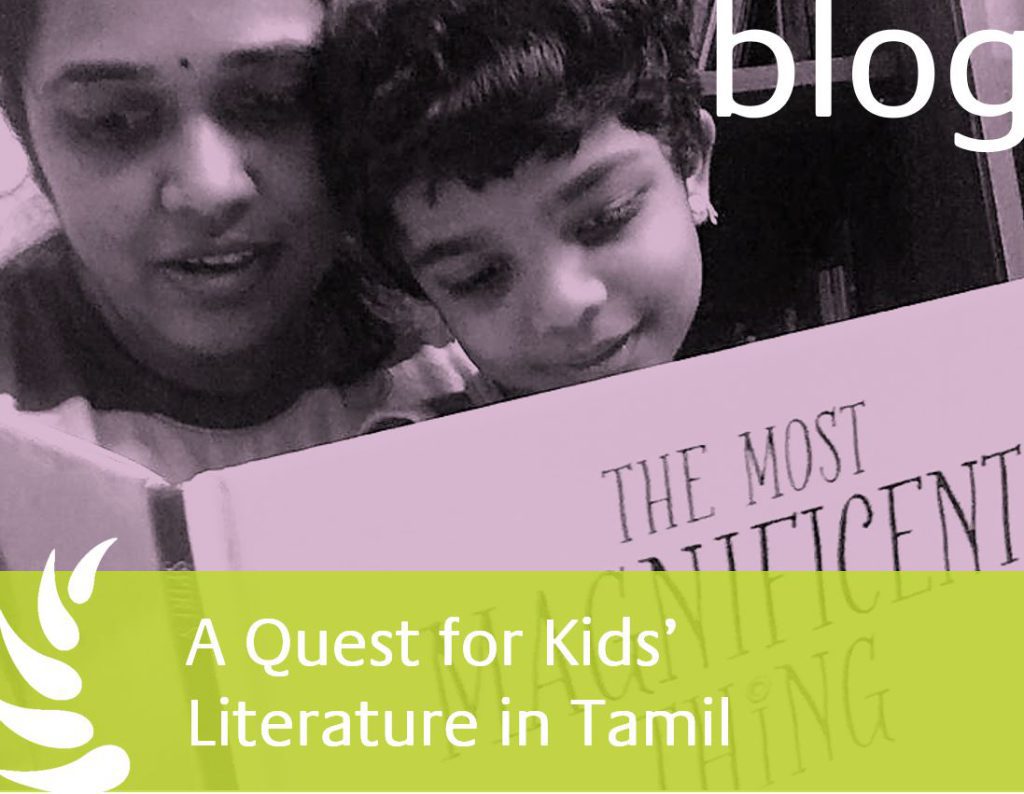A Quest for Kids’ Literature in Tamil
By Akila Surendran,
As a kid, I grew up reading English books like the Ladybird series, Disney’s fairytales, Aesop’s fables and Enid Blyton’s. Other memories are of my grandmother relating Hindu mythological stories to me in our regional language, Tamil. These stories were mesmerising. They fed my imagination. They shaped my perspectives and understanding of the world. I distinctly remember my father telling that I’m reading too many books from the western culture, which don’t reflect our own society and values. I did not understand the significance of his observation back then. I guess my ‘dual life’ began there – my inability to completely relate to either of the two worlds. With the books from the West, I felt a sense of incompleteness with my real life and a longing for the life I read about in the books. I yearned to experience it and had a glimpse of it during my higher education days abroad.
Back to the present. My daughter, Nila is four years old now and we look forward to our ‘reading time’ every day. For Nila, reading means listening and watching me bring alive to her another world filled with her favourite characters. To me, it means spending quality time with her, reliving my childhood memories and seeing these books in a new perspective – as a parent. I have consciously instilled the ‘Enid Blyton’ bias in Nila. It’s a positive feedback loop – I tell these stories to her with more vigour, she feeds off it and responds with equal or more energy.
We started off with Eric Carle and Julia Donaldson and moved on to Ruskin Bond, Roald Dahl and Enid Blyton, as Nila’s capacity to understand and remember complex plot-lines grew. These books are a worthwhile investment (Eric Carle and JD are quite expensive). They are colourful, inspire imagination, build language and promote values like sharing and inclusion. From the start, I have been looking, with less success, for similar books in Tamil or Malayalam. I have to read and translate English books for Nila to comprehend. I want equivalent books in our regional language for Nila’s grandparents to read to her too. Currently, they tell her traditional Indian mythological stories – I have come to see this as a ‘can of worms’. I do understand that this is part of our culture and I grew up with these stories (and loved them) too. But now I see these tales as reeking of violence, patriarchy, ‘might is right’ and unreal black-and-white characterization.
I cannot shield my kids forever. This gives me an opportunity to make them aware of these ‘forces’ in our culture and build their ‘self-advocacy’ skills to resist. So, I let Nila listen to these stories and then we have long ‘book review’ discussions where we compare actual kids’ literature with these similarly labelled, harmful books. I go into these discussions hesitatingly, worried if this is too much information for a four-year old to handle. But I have never been disappointed by Nila’s poise and aplomb to take it all in, weigh it in her head and arrive at her own conclusions.
Coming back to Enid Blyton – I see my favorite childhood author in a different light now. All her stories reinforce, ‘girls sew and clean up while boys ‘take care’ of them’. Bursts my bubble 😔. We do continue reading the Blyton books, but I filter out this biased content. The books are still filled with fun, food and adventures that Nila and I love. I’m waiting for Nila to grow up and read these books on her own and wonder why her amma presented these stories to her differently. 🤔
I am looking forward to buying works of குழந்தைக் கவிஞர் அழ. வள்ளியப்பா (Kids’ poet, Azha Valliappa), trying some Tamil books from Tulika and printing some Tamil/Malayalam stories off http://storyweaver.org.in/ . Nila and I might even start writing our own stories in Tamil for other kids to read!
If you liked this read, do check out my other blog posts at http://akilasurendran.blogspot.com/
Akila, who is a friend of kanthari comes from Madurai, a city in south India, where the ancient and modern co-exist. Her training in
science helps her to objectively view the two worlds. Her current job with persons with disabilities gives her a broad perspective of human abilities, societal determinants and how modern technology can catalyse attitudinal shifts’

